Gawain
Gawain (/ɡəˈweɪn/; Welsh: [ˈɡawain]), also known as Gawaine or Gauwaine, among various other forms and spellings, is King Arthur's nephew and a Knight of the Round Table in the Arthurian legend. Under the name Gwalchmei, he is introduced very early in the legend's literature, being mentioned in some of the earliest Welsh Arthurian sources. As Gawain, he appears in Latin, French, English, Dutch, German and Italian texts, notably as the protagonist of the story of Sir Gawain and the Green Knight. Other tales of Gawain include Historia Regum Britanniae, Roman de Brut, De Ortu Waluuanii, Diu Crône, The Awntyrs off Arthure, Ywain and Gawain, Golagros and Gawane, L'âtre périlleux, Le Chevalier à l'épée, and The Weddynge of Syr Gawen and Dame Ragnell, as well as the works of Chrétien de Troyes and the prose cycle Lancelot-Grail.
| Gawain | |
|---|---|
| Matter of Britain character | |
Sir Gawaine the Son of Lot, King of Orkney, by Howard Pyle from The Story of King Arthur and His Knights (1903) | |
| Based on | Gwalchmei |
| In-universe information | |
| Title | Prince, Sir |
| Occupation | Knight of the Round Table |
| Family | Later tradition: Lot, Morgause, Agravain, Gaheris, Gareth, Mordred, King Arthur, Morgan le Fay |
| Children | Various, including Gingalain |
| Origin | Orkney and/or Lothian |
Gawain is one of a select number of Round Table members to be referred to as one of the greatest knights and closest companions of King Arthur. He is usually the son of Arthur's sister Morgause (or Anna) and King Lot of Orkney and Lothian, and his brothers or half-brothers are Agravain, Gaheris, Gareth, and Mordred. He is often portrayed as a formidable, courteous, and also a compassionate warrior, fiercely loyal to his king and family. As such he is a friend to young knights, a defender of the poor, and as "the Maidens' Knight", a defender of women as well. He has a horse named Gringolet, uses the sword Excalibur, and his sons may include the "Fair Unknown", Gingalain. One recurring theme of later versions of Gawain's legend is his friendship with Lancelot, who eventually becomes his bitter enemy. Gawain's usually glowing portrayals are diminished in the Lancelot–Grail Cycle in favour of Lancelot and especially Galahad, and his character even turns markedly ignoble in the Post-Vulgate Cycle and outright villainous in the Prose Tristan.
Name
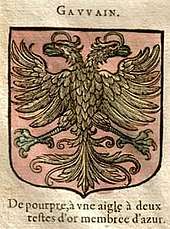
Gawain is known by different names and variants in different languages. The character corresponds to the Welsh Gwalchmei ap Gwyar, and is known in Latin as Walwen, Gualguanus, Waluanus, etc.; in French as Gauvain; in German as Gawein; in Italian as Galvagin and Galvano, and in English as Gawain. The later forms are generally assumed to derive from the Welsh Gwalchmei.[1] The element Gwalch means hawk, and is a typical epithet in medieval Welsh poetry.[2] The meaning of mei is uncertain. It has been suggested that it refers to the month of May (Mai in Modern Welsh), rendering "Hawk of May", Rachel Bromwich considers this unlikely. Kenneth Jackson suggests the name evolved from an early Common Brittonic name *Ualcos Magesos, meaning "Hawk of the Plain".[2]
The Gwyar (meaning "gore"[3] or "spilled blood/bloodshed"[4]) in Gwalchmei ap Gwyar is likely the name of Gwalchmei's mother, rather than his father as is the standard in the Welsh Triads.[1] Matronyms were sometimes used in Wales, as in the case of Math fab Mathonwy and Gwydion fab Dôn, and were also fairly common in early Ireland.[1] Gwyar appears as a daughter of Amlawdd Wledig in one version of the hagiographical genealogy Bonedd y Saint. Additionally, the 14th-century Birth of Arthur, a Welsh text adapting scenes from Geoffrey of Monmouth, substitutes Gwyar for "Anna", Geoffrey's name for Gawain's mother, named Morgause in the later French-inspired tradition.[5] Other sources do not follow this substitution, however, indicating that Gwyar and Anna originated independently.[6]
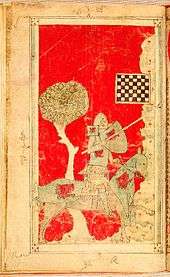
Not all scholars accept the gwalch derivation. John Koch suggests the name could be derived from a Brythonic original *Wolcos Magesos, "Wolf/Errant Warrior of the Plain."[7] Others argue that the continental forms do not ultimately derive from Gwalchmei. Roger Sherman Loomis suggests a derivation from the epithet Gwallt Avwyn, found in the list of heroes in Culhwch and Olwen, which he translates as "hair like reins" or "bright hair".[8][9] Lauran Toorians proposes that the Dutch name Walewein (attested in Flanders and France c. 1100) was earliest, suggesting it entered Britain during the large settlement of Flemings in Wales in the early 12th century.[10] However, most scholarship supports a derivation from Gwalchmei, variants of which are well attested in Wales and Brittany. Scholars such as Bromwich, Joseph Loth, and Heinrich Zimmer trace the etymology of the continental versions to a corruption of the Breton form of the name, Walcmoei.[1]
Gwalchmei
Gwalchmei (or Gwalchmai) was a traditional hero of Welsh mythology. His popularity greatly increased after foreign versions, particularly those derived from Geoffrey of Monmouth's Historia Regum Britanniae, became known in Wales.[11]
An early Welsh romance Culhwch and Olwen, written in the 11th century and eventually associated with the Mabinogion,[12] ascribes to Gwalchmei the same relationship with Arthur that Gawain is later given: he is a son of Arthur's sister and one of his leading warriors[2] (in the 14th-century Welsh text The Birth of Arthur, Gwalchmei is given three sisters: Gracia, Graeria, and Dioneta, the last one of them being a counterpart of Morgan[13]). However, he is mentioned only twice in the text; once in the extensive list of Arthur's court towards the beginning of the story, and again as one of the "Six Helpers" who Arthur sends with the protagonist Culhwch on his journey to find his love Olwen.[11] Unlike the other helpers he takes no further part in the action, suggesting he was added to the romance later, likely under the influence of the Welsh versions of Geoffrey's Historia.[11] He also appears in Peredur fab Efrawg (Peredur son of Efrawg) part of the Mabinogion, where he aids the hero Peredur in the final battle against the nine witches of Caer Loyw.[14] A tale recorded by 16th-century Welsh scholar Sion Dafydd Rhys mentions how Gwalchmai destroyed three evil witch-sisters, wives of the giants previously slain by Arthur, killing them within their castles through his cunning as they could not be defeated otherwise due to their powers.[15]
In any case, Gwalchmei was clearly a traditional figure in Wales. Other early references to him include the Welsh Triads; the Englynion y Beddau (Stanzas of the Graves), which lists the site of his grave; the Trioedd y Meirch (Triads of the Horses), which praises his horse named Keincaled (known as Gringolet in the works of medieval French authors); and Cynddelw's elegy for Owain Gwynedd, which compares Owain's boldness to that of Gwalchmei.[2] In the Welsh Triads, Triad 4 lists him as one of the "Three Well-Endowed Men of the Isle of Britain" (probably referring to his inheritance);[16] Triad 75 describes him as one of the "Three Men of the Island of Britain who were Most Courteous to Guests and Strangers";[17] and Triad 91 praises his fearlessness.[18] Some versions of Triads 42 and 46 also praise his horse Keincaled, echoing the Triads of the Horses.[19] The singling out of Gwalchmei out as Most Courteous evokes his role in the Mabinogion, where he regularly serves as an intermediary between stranger knights and Arthur's court.[20]
Gawain
Life and death

A few references to Gawain appear outside Wales in the first half of the 12th century. For instance, William of Malmesbury writes in his Gesta Regum Anglorum of around 1125 that "Walwen's" grave had been uncovered in Pembrokeshire during the reign of William the Conqueror; William recounts that Arthur's nephew had been driven from his kingdom by the Saxons led by Hengest's brother, though he continued to harry his enemies severely.
However, it was Geoffrey of Monmouth's version of Gawain in the Historia Regum Britanniae, written around 1136, that brought the character to a wider audience.[21] As in the Welsh tradition, Geoffrey's Gawain (Gualguanus) is the son of Arthur's sister, here named Anna, and her husband is Lot (Loth), the prince of Lothian and one of Arthur's key supporters. Gawain is depicted as a superior warrior and potential heir to the throne until he is tragically struck down by the forces of his traitorous brother Modredus at Richborough, during an attempted sea landing turned a disaster.[22] Geoffrey mentions that Gawain was twelve years old at the time when King Lot and Arthur began a war with Norway and that he had previously served Pope Sulpicius in Rome.
Geoffrey's work was immensely popular and was adapted into many languages. The Norman version by Wace, the Roman de Brut, ascribes to Gawain the chivalric aspect he would take in later literature, wherein he favours courtliness and love over martial valor.[21] Several later works expand on Geoffrey's mention of Gawain's boyhood spent in Rome, the most important of which is the anonymous Medieval Latin De Ortu Waluua Nepotis Arturi (The Rise of Gawain, Nephew of Arthur), which describes his birth, boyhood, and early adventures leading up to his knighting by his uncle.[23]
Beginning with the five works of Chrétien de Troyes, Gawain became a particularly popular figure in the Old French chivalric romances. Chrétien features Gawain as a major character and establishes some characteristics that pervade later depictions, including his unparalleled courteousness and his way with women. His romances set the pattern often followed in later works in which Gawain serves as an ally to the protagonist and a model of knighthood to whom others are compared. However, in Chrétien's later romances, especially Lancelot, le Chevalier de la Charrette (Lancelot, the Knight of the Cart) and Perceval ou le Conte du Graal (Perceval, the Story of the Grail), the eponymous heroes Lancelot and Percival prove morally superior to Gawain who follows the rules of courtliness to the letter rather than the spirit.[21] Chrétien's story of Yvain, Yvain ou le Chevalier au Lion (Yvain, the Knight of the Lion), was translated into the Middle English as Ywain and Gawain. Gawain is also prominent in the continuations of Perceval, including Perlesvaus.
An influx of romances written in French appeared in Chrétien's wake, and in these Gawain was characterised variously. In many of these "Gawain romances", such as Le Chevalier à l'épée (The Knight with the Sword) and La Vengeance Raguidel (or Messire Gauvain), he is the hero; in others, he aids the hero; sometimes he is the subject of burlesque humor.[21] In the variants of the Bel Inconnu (Fair Unknown) story, he is the father of the hero.[24] In Perceval and some other stories, he is the other wielder of Arthur's magic sword Excalibur; in the English Alliterative Morte Arthure, he has a sword named Galuth, which bears the name Galatine in Thomas Malory's Roman War episode.
For the English and the Scots, Gawain remained a respectable and heroic figure, becoming the subject of several romances and lyrics in the dialects of their nations, such as the Middle Scots poem Golagros and Gawane. Important English Gawain romances include The Awntyrs off Arthure (The Adventures of Arthur) and The Avowyng of Arthur (The Avowing of Arthur). The Middle Dutch romance Roman van Walewein (Story of Gawain) by Penninc and Pieter Vostaert and the Middle High German romance Diu Crône (The Crown) by Heinrich von dem Türlin are both dedicated primarily to Gawain.
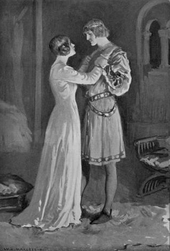
Gawain is notably the hero of one of the greatest works of Middle English literature, the alliterative poem Sir Gawain and the Green Knight, where he is portrayed as an excellent, but human, knight. In the poem, he must go to the titular Green Knight to, assumingly, be killed by the Knight. Gawain does this as it pertains to a deal made between the two without knowing that it is all a test by the Knight.[25] Gawain is cited in Robert Laneham's letter describing the entertainments at Kenilworth in 1575,[26] and the recopying of earlier works such as The Greene Knight suggests that a popular English tradition of Gawain continued. In possibly Malory's The Weddynge of Syr Gawen and Dame Ragnell (The Wedding of Sir Gawain and Dame Ragnelle), his wits, virtue and respect for women frees his wife, a loathly lady, from her curse of ugliness. The Child Ballads include a preserved legend in the positive light: The Marriage of Sir Gawain, a fragmentary version of the story of The Wedding of Sir Gawain and Dame Ragnelle.
In the Lancelot-Grail (Vulgate Cycle), Gawain is depicted as a proud and worldly knight and the leader of his siblings, who demonstrates through his failures the danger of neglecting the spirit for the futile gifts of the material world. On the great Grail quest, his intentions are always the purest, but he is unable to use God's grace to see the error in his ways. Later, when his brothers Agravain and Mordred plot to destroy Lancelot and Guinevere by exposing their love affair, Gawain tries to stop them. When Guinevere is sentenced to burn at the stake and Arthur deploys his best knights to guard the execution, Gawain nobly refuses to take part in the deed even though his brothers will be there. But when Lancelot returns to rescue Guinevere, a battle between Lancelot's and Arthur's knights ensues and Gawain's brothers Gareth and Gaheris are killed (Agravain too is killed by Lancelot, either on this occasion or in a previous encounter). This turns his friendship with Lancelot into hatred, and his desire for vengeance causes him to draw Arthur into a war with Lancelot in France. In the king's absence, Mordred usurps the throne, and the Britons must return to save Britain. Meanwhile, Gawain is mortally wounded by Lancelot himself after a long duel.
Gawain's death is described in more detail in the Alliterative Morte Arthure. On reaching land, Gawain wreaks great slaughter on the enemies, killing the king of Gothland among others, before being surrounded on a hill. He pushes forward on horse against Mordred and the two strike one another down from their horses with their lances; Gawain then attempts to cut Mordred's throat but Mordred stabs him though the helmet, and then gives a sorrowful eulogy to his dead brother, the best and most glorious of knights. In the Didot Perceval, Gawain attempts to disembark when one of Mordred's Saxon allies fatally strikes him in the head through an unlaced helmet; a similar account is told in the Stanzaic Morte Arthur.
Thomas Malory's English compilation work Le Morte d'Arthur (The Death of Arthur) is based mainly, but not exclusively, on French works from the Vulgate and Post-Vulgate Cycles. Here Gawain partly retains the negative characteristics attributed to him by the later French authors, and partly retains his earlier positive representations, creating a character seen by some as inconsistent, and by others as a believably flawed hero. Gawain is the first to declare that he "shall laboure in the Queste of the Sankgreall" but really embarks on the Grail quest in order to gain more magical meals and drinks (metys and drynkes) from it rather than from a religious zeal or to save the Fisher King's kingdom. One of Malory's other French sources was L'âtre périlleux (The Perilious Cemetery), a poem about Gawain's rescue of a woman from a demon.
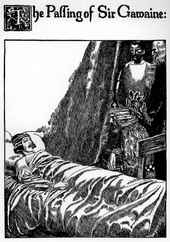
In Malory's version, after Guinevere is condemned by Arthur to be burnt at the end of Le Morte d'Arthur, Lancelot comes to rescue her. But Mordred has sent word to King Arthur; Arthur sends a few knights to capture Lancelot, and Gawain, being a loyal friend to Lancelot, refuses to take part in the mission. The clash between Lancelot's party and Arthur's knights results in Gawain's two sons and his brothers, except for Mordred, being slain. This begins the vengeful hostility of Gawain, drawing Arthur himself into a war with Lancelot, first in Britain and then in France. Gawain's rage is so great that he refuses to cease fighting even after the Pope steps in and issues a bull to end the violence between Arthur's and Lancelot's factions. Following Mordred's betrayal, Gawain wages two wars against both Mordred and Lancelot. He twice challenges Lancelot to a duel, but each time loses and asks Lancelot to kill him; Lancelot refuses and grants him mercy before leaving. The mortally injured Gawain later writes to Lancelot, repenting of his bitterness, asking for his help against Mordred, and for forgiveness for splitting the Round Table. Following his death, Gawain also appears in Arthur's dream vision to tells him to wait thirty days for Lancelot to return to Britain before fighting Mordred, and Arthur sends Lucan and Bedivere to make a temporary peace treaty, but the bloody final conflict ensues anyway. Upon his eventual arrival, Lancelot weeps at Gawain's tomb for two nights. In his introduction to Malory's Le Morte d'Arthur, William Caxton wrote that those visiting Dover Castle can still "may see the skull of [Sir Gawaine], and the same wound is seen that Sir Launcelot gave him in battle."[27]
In the Italian romance La Tavola Ritonda, Gawain, after being defeated in his duel with Lancelot, takes part in resisting an attack by Lancelot's friend and ally, Sir Turinoro of Cartagina. In a single combat with Turinoro, Gawain is struck on his head in the same place where Lancelot had wounded him and falls dead; Turinoro also dies. In Jean des Preis' Belgian Ly Myreur des Histors, Arthur, defeated and wounded in his last battle with Mordrech (Mordred), goes with Gawain in a boat to the magic isle of Avalon for them to be healed there by his sister Morgaine (Morgan). The surviving Gawain also features in the earlier French epic poem La Bataille Loquifer, appearing together with Arthur and Morgan in Avalon, where they are all still alive hundreds of years later.
Origin narratives and alternate siblings
Les Enfances Gauvain, based in part on De Ortu Waluuanii, tells of how Arthur's sister Morcades (Morgause) becomes pregnant by Lot, at this point a mere page in King Arthur's court. She and Lot secretly give the child to a knight named Gawain the Brown (Gauvain li Brun) who baptises the child with his own name and puts the infant Gawain in a cask with a letter explaining who the child is and sets him adrift on the sea. The cask is found by a fisherman and his wife. Sometime after Gawain is ten years of age, his foster-father vows to make a pilgrimage to Rome if he recovers from his severe illness. When he indeed does, he takes his foster-child with him to Rome, where a clerk reads the letter and understands that the boy is of high birth and the Pope takes Gawain as his own foster-son. Accounts similar to this can be found in Perlesvaus, the Gesta Romanorum, and many other texts.
In De Ortu Waluuani, the young Gawain, incognito as the Knight of the Surcoat, undertakes a duel to determine whether Rome or Persia should possess Jerusalem. On his way, Gawain and his men defeat the pirate king Milocrates and his brother Buzafarnam, rescuing the Emperor's niece whom Milocrates has abducted. In Jerusalam, he fights the giant Persian champion Gormund and slays him after three days of single combat. He is then sent to King Arthur with the proof of his birth. Arthur's queen, here named Gwendoloena and possessing prophetic powers, warns Arthur of the coming of a knight of Rome who is more powerful than him; Arthur and Kay meet Gawain on his way but he unhorses them both. Gawain then arrives at Arthur's court, but the king rejects him despite learning of the knight being his nephew. In response, Gawain vows that he will do what Arthur's entire army could not do. The occasion comes when the Lady of the Castle of Maidens sends to Arthur for aid, having been abducted by a pagan king who wants to force marriage on her; Arthur and his forces go to fight the pagan army but lose, yet Gawain single-handedly succeeds and returns with the Lady and with the pagan king's head. Arthur is finally forced to publicly accept the knight's worth, and Lot and Anna formally acknowledge Gawain as their son.
Similar to this tale are the stories of the Castle of Wonders in Chrétien's Perceval, Wolfram von Eschenbach's Parzival, Diu Crône, and the Norse Valvens þáttr (The Tale of Gawain), wherein Gawain comes to the castle where, unknown to him, live his grandmother (King Arthur's mother), his own mother, and his sister. Gawain ends the adventure of the castle and becomes its lord. It would be only right by normal rules if he married unknowingly either his mother or his sister, but Gawain discovers who the women are. In a variant included in the Gesta Romanorum, Gawain-derived character named Gregory comes to a castle where his mother dwells, besieged by the Duke of Burgundy. Gregory enters the lady's service and succeeds in winning back her lands, after which he unwittingly marries his own mother.
Later romances, however, abandon the motif of Gawain being brought up, unknown, in Rome. In the Suite du Merlin attributed to Robert de Boron, a marriage between King Lot and a daughter of Ygerne (Igraine, Arthur's mother) is part of the negotiations arranging for Arthur's father Uther Pendragon's marriage to Ygerne; Gawain must be thus about the same age as Arthur, or even older. In the Vulgate Merlin, he first appears as a young squire in his father's kingdom. Gawain, his brother Gaheris, and a number of other squires, most of them sons or kindred of the kings who are rebelling against King Arthur, come together and defend the land of Logres against the Saxons while Arthur is away aiding King Leodegan (Leodegrance) against King Rion (Rience), after which Arthur knights the squires. During this time, Gawain saves their mother Belisent (Morgause) and the infant Mordred from being kidnapped by the Saxon king Taurus. This is different in the Post-Vulgate Merlin, where King Lot fights against Arthur but his forces are defeated and he himself is killed by King Pellinor (Pellinore), one of King Arthur's allies. Gawain appears as an eleven-year-old boy at Lot's funeral and swears to avenge his father's death on Pellinor, praying that he may never be known for knightly deeds until he has taken vengeance. The story of the feud of between Gawain and Pellinor and his sons is very important in the Post-Vulgate Cycle and the Prose Tristan, but not a trace of it is found in the Lancelot-Grail Cycle or in any earlier known tale, some of which picture Lot as still alive long after Gawain becomes a knight.
In many works outside the Lancelot-Grail inspired tradition, Gawain has sisters. They include an unnamed sister in Chrétien's Yvain (whom he rescues along with her unnamed husband and children from a giant), an unnamed sister in Hunbaut (who is abducted by Gorvain Cadru), Soredamors (the mother of Cligés) and Clarissant in Chrétien's Cligés, and Elainne in the Modena manuscript of the Didot Perceval. In Parzival, he also has second sister named Cundriê and a younger brother named Beacurs (Gawain's sole male sibling in this version).
Differing characterizations
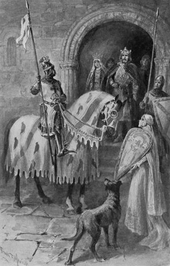
Traditionally, Gawain in particular of all Arthur's knights is known for his courteousness, compassion and humbleness. In Gawain: His Reputation, His Courtesy and His appearance in Chaucer's Squire's Tale, B.J. Whiting collected quantitative evidence of this quality being stronger in Gawain than in any of the other Knights of the Round Table, counting the words "courteous", "courtesy" and "courteously" being used in reference to Arthur's nephew as 178 times in total, more than for all the other knights in Arthurian literature.[28] The Prose Lancelot, describes Gawain as the most handsome of his brothers and notably gracious towards the poor people and to societal outcasts such as lepers. In some versions of the legend, Gawain would have been the true and rightful heir to the throne of Camelot, after the reign of King Arthur.[23][29]
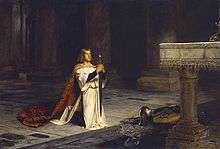
According to the Vulgate Mort Artu, Gawain had been baptised as an infant by a miracle-working holy man, also named Gawain, who named the boy after himself, and the following day announced that every day at noon, at the hour of the baptism, his power and strength will increase. His knowledge of herbs also makes him a great healer,[30] as shown in Chrétien's Perceval, Valvens Þáttr, Parzival, Walewein, and the Dutch Lancelot Compilation (in the stories Moriaen, Die Riddere metter Morwen, Walewein ende Keye, and Lancelot en het Hert met de Witte Voet). In Sir Gawain and the Green Knight, Gawain's persona is also said to be founded in a deep Christian belief in Christ and the Virgin Mary.[31]
In the Vulgate Queste del Saint Graal, however, he is used as a symbol of the unfitness of secular knighthood. Gawain is blamed for his irreligion and is shown to indulge in rather purposeless killing, as for example he mortally wounds his relative and a fellow Knight of the Round Table, Ywain the Bastard in one of the many random jousting duels for no particular reason (failing to even recognise each other until it is too late), just as he is also responsible for the deaths of more his fellow Round Table companions, including the young King Bagdemagus of Gorre whom he accidentally kills during a tournament. The Vulgate Mort Artu even says Gawain had killed some of his fellow Knights of the Round Table in the quest for the Grail, of which he turned out to be unworthy to achieve. In the end, his unwillingness to forgive Lancelot leads to his own death and contributes to the downfall of Arthur's kingdom.
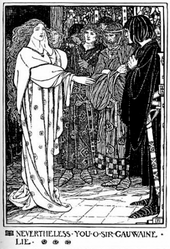
In the Post-Vulgate Cycle, Gawain's character is further blackened, highly influenced by his portrayal as a villain in the Prose Tristan.[32] He is now bloodthirsty and often murderous. Among important Knights of the Round Table whom Gawain is said to have killed during and after the Grail quest are King Pellinor's son Agloval (Aglovale), King Lac's son Erec, and King Esclabor's son Palamedes (resulting in Escablor's own death from grief). Earlier, Gawain and his brothers are also the slayers of King Pellinor and his sons Driant and Lamorat (Lamorak). Although Gawain still has a reputation for being one of the best and most courteous knights in the world, this is a sham as he is often secretly a rapist of damsels and a killer of good knights, no better than his brother Agravain. When the mighty and holy Grail knight Perceval asks Gawain if he had killed his father Pellinor, Gawain simply lies and denies it out of fear of him.
The Guiron le Courtois section of Palamedes explains Gawain's many great cruelties by his grief at being surpassed by other knights after not regaining his full strength following the war with Galehaut. Such new popular image originating in the late Old French romance tradition prompted the historical audience of The Wife of Bath's Tale to identify the story's rapist-knight character as Gawain.[33] Malory's Gawain, following the later French portrayals, also "emerges as a character composed of obvious inconsistencies of virtue and evil."[34]
Children and relationships
Hartmann von Aue's Erec is the first to mention Gawain's offspring, listing one "Henec the Skillful, son of Gawain" (Henec suctellois fil Gawin) among the Knights of the Round Table. Thomas Malory credits Gawain with three sons through the Lady of Lys (a sister of Bran de Lys/Lis, or "Brandles" in the Middle English The Jeaste of Syr Gawayne[35]). They are named Florence, Lovell and Gingalain. Both Lovell (Lioniel) and Gingalain (Guinglain) had previously appeared in the First Continuation to Chrétien's Perceval and in the Livre d'Artus. Gingalain is the only of them to play significant roles in further works as the eponymous character of the Old French romance Le Bel Inconnu (The Fair Unknown) by Renaud de Beaujeu,[36] as well as of the Middle English romance Libeaus Desconus and of its Middle High German version Wigalois (Gingalain's name in it) by Wirnt von Grafenberg. Besides them, the also eponymous hero of Beaudous by Robert de Blois is the son of Gawain by an unnamed daughter of the king of Wales; in the Prose Lancelot, a daughter of King Tradelmant of North Wales becomes pregnant by Gawain out of wedlock.
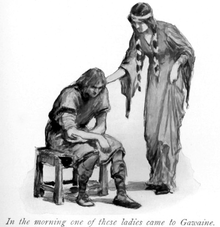
Since Gawain is known in multiple tales as "the Maidens' Knight", his name being thus attached to no woman in particular. As such, he is the champion of all women, and through this reputation, he has avoided the name pairing seen in tales of Erec and Lancelot (the former being inextricably linked with Enide, the latter with Guinevere). He has been, however, also given wives in the course of Arthurian literature.[37] In The Wedding of Sir Gawain and Dame Ragnelle, he marries the cursed Ragnelle, and in giving her "sovereignty" in the relationship, lifts the spell laid upon her that had given her a hag-like appearance.[38] In Parzival, Gawain marries Orguelleuse, the widow of the Duke of Logres. (In Perlesvaus, Orguelleuse instead unsuccessfully plots to kill Gawain and then to entomb herself with him; she is called the Maiden of the Narrow Wood in Hunbaut.)
He is also associated with a vague supernatural figure in various tales, sometimes the princess/queen of the Otherworld.[39] The hero of Le Bel Inconnu is the progeny of Gawain and a fairy called Blancemal, and in The Marvels of Rigomer (Les Merveilles de Rigomer), Gawain is rescued by the fay Lorie.[40][41] In Wigalois, the mother of his son is known as Florie, likely another version of the Lorie from Rigomer. In Italian romance La Pulzella Gaia, Gawain fight and defeats a fairy in the form of a giant serpent, who turns out to be the daughter of his own aunt Morgan le Fay (Fata Morgana) and becomes his secret lover; their relationship, once revealed, makes them both enemies of Guinevere (jealous of Gawain after having been spurned), Arthur, and Morgan all at once.[42] Le Morte d'Arthur mentions Gawain having been once in the power of the lustful witch Hellawes.[43]
In many romances, Gawain is depicted as a model for chivalric attribute.[40] In Sir Gawain and the Green Knight, for example, where he is described as "this fine father of breeding",[44] Gawain receives the kisses of Lady Bertilak with discretion, at once not wanting to insult her by refusing her advances and not wanting to betray the hospitality of her husband.[45] In Sir Gawain and the Green Knight, based on the bargain to give each other their respective daily gains, Gawain must give the kisses he receives from Lady Bertilak to Sir Bertilak. This allusion serves to reinforce chivalric ideals of religious, martial and courtly love codes, especially in masculine warrior culture, and shows the ways in which the masculine world can be subverted by female wiles.[46] This undertone of homoeroticism between Gawain and Sir Bertilak underscores the strength of male homosocial bonds, and the fact that sex never occurs reinforces ideals of the masculine chivalric code.[47] The Vulgate Mort Artu has Gawain's corpse carried to Camelot by a hundred knights. The knights arrive at castle Beloë, the lord of which had envied Gawain and hated him, but his wife declares in her sorrow that she has never loved any man but Gawain and will never love another as long as she lives; the lord of Beloë draws his sword and kills her in anger and the knights kill him in turn. After the arrival at Camelot, Gawain's body is placed in the tomb of his dear brother Gaheriet (Gaheris).
Modern portrayals

Gawain features frequently in modern literature and media. Modern depictions of him are often heavily influenced by Malory, though characterisations are inconsistent. Alfred Tennyson adapted episodes from Malory to present Gawain as a worldly and faithless knight in his Idylls of the King.[49][50][51] Similarly, T. H. White's novel The Once and Future King follows Malory, but presents Gawain as more churlish than Malory's torn and tragic portrayal.[52] In contrast, Thomas Berger's Arthur Rex portrays Gawaine as open-minded and introspective about his flaws, qualities that make him the Round Table's greatest knight.[53] Though he usually plays a supporting role, some works feature Gawain as the main character. Vera Chapman's The Green Knight and Anne Crompton's Gawain and Lady Green offer modern retellings of Sir Gawain and the Green Knight.[54] Gwalchmai is the protagonist in Gillian Bradshaw's Celtic-tinged Hawk of May and its sequels,[55] and an aged Gawain is one of the central characters in Kazuo Ishiguro's novel The Buried Giant.[56]
Film portrayals of Gawain, and the Arthurian legend in general, are heavily indebted to Malory; White's The Once and Future King also exerts a heavy influence. Gawain appears as a supporting character in films such as Knights of the Round Table (1953, played by Robert Urquhart) and Excalibur (1981, played by Liam Neeson), all of which draw on elements of his traditional characterisations.[57] Other films give Gawain a larger role. In the 1954 adaptation of Prince Valiant, he is a somewhat boorish, though noble and good-natured, foil for his squire and friend, Valiant.[58] He plays his traditional part in the 1963 film Sword of Lancelot (played by George Baker), seeking revenge when Lancelot kills his unarmed brother Gareth, but ultimately coming to Lancelot's aid when he uncovers Mordred's responsibility.[59] Sir Gawain and the Green Knight has been adapted to film several times, including 1973's Gawain and the Green Knight (played by Murray Head) and 1984's Sword of the Valiant (played by Miles O'Keeffe), both directed by Stephen Weeks; neither film was well reviewed and both deviate substantially from the source material.[60] A 1991 television adaptation by Thames Television, Gawain and the Green Knight, was both more faithful and better received.[61] Other film portrayals included Robert Gwyn Davin's in First Knight (1995), Anthony Hickox in Prince Valiant (1997), Sebastian Roché in Merlin (1998), Noah Huntley in The Mists of Avalon (2001), and Joel Edgerton in King Arthur (2004). In the 2008 television series Merlin, Gawain appears as Sir Gwaine, played by Eoin Macken. Though of noble origin, he passes himself as a peasant due to his mother's mistreatment by the king his father served; he is finally knighted by Arthur due to his personal value. In the 2011 series Camelot, he is played by Clive Standen. In the 2017 television series Knightfall, Sir Gawain, played by Pádraic Delaney, is portrayed as one of the leading figures of the Knights Templar in France. In 2020's Cursed, Gawain played by Matt Stokoe doubles as the Green Knight.
The character has appeared in a number of stage productions and operas, mostly interpretations of Sir Gawain and the Green Knight. Particularly notable among them is the 1991 opera Gawain with music by Harrison Birtwistle and a libretto by David Harsent.[62] Gawain also appears in video games, including as the protagonist of Chronicles of the Sword. He is voiced by Takahiro Mizushima in Fate/EXTRA and its sequel Fate/EXTRA CCC, as well as in Fate/Grand Order. In Sonic and the Black Knight (2009), Sir Gawain is one of the main characters, based on Knuckles the Echidna. He also featured in the video game Age of Empires II: The Age of Kings as a cavalier.
See also
References
Citations
- Bromwich, p. 369.
- Bromwich, p. 367.
- Pughe, p. 195
- Rhys, p. 169.
- Bromwich, pp. 369–70.
- Bromwich, p. 370.
- Koch, "The Celtic Lands," p. 267.
- Roger Sherman Loomis, The Grail (Princeton University Press, 1963), p. 272
- Roger Sherman Loomis, Celtic Myth and Arthurian Romance (Academy Chicago Publishers, 1997), pp. 63–66.
- Toorians, Lauran, "Nogmaals 'Walewein van Melle' en de Vlaams-Keltische contacten," Queeste, 2 (1995), 97–112.
- Bromwich, p. 368.
- Hall, pp. 2–3.
- Barber, Chris; Pykitt, David (1997). Journey to Avalon: The Final Discovery of King Arthur. Weiser Books. ISBN 978-1609251468.
- "Peredur". Academic Dictionaries and Encyclopedias. Retrieved 5 December 2018.
- The Giants of Wales and Their Dwellings by Sion Dafydd Rhys (Peniarth MS 118 f.829–837, ca. 1600].
- Bromwich, p. 9.
- S Davies, Mabinogion (Oxford 2007) p. 245
- Bromwich, pp. 205, 234.
- Bromwich, pp. 111–12, 127–28.
- S Davies trans., Mabinogion (Oxford 2007) p. 245.
- Busby, pp. 178–79.
- Geoffrey of Monmouth, Historia Regum Britanniae Books 9–11.
- Day, Mildred Leake (1994), "The Rise of Gawain, Nephew of Arthur", in Wilhelm, James J. (ed.), The Romance of Arthur, New York: Garland, pp. 365–66
- Lacy, p. 161.
- "Sir Gawain and the Green Knight." From the Norton Anthology of English Literature, edited by Julie Reidhead, lines 2331–2365.
- Performance artist Captain Cox is described as "hardy as Gawin" and knows the Arthurian romances including "Syr Gawain".
- C. Norris, Ralph (2008). Malory's Library: The Sources of the Morte Darthur. D.S. Brewer. p. 200. ISBN 978-1843841548.
- Whiting, p. 218.
- Hall, p. 3.
- Whiting, p. 194.
- "Sir Gawain and the Green Knight." Translated by Simon Armitage. The Norton Anthology of English Literature. Edited by Julie Reidhead. New York: W.W. Norton & Company, Inc., 2012. Lines 642–647.
- https://books.google.com/books?id=IwwNAQAAIAAJ&pg=PA56
- Gastle, Brian; Kelemen, Erick (2018). Later Middle English Literature, Materiality, and Culture: Essays in Honor of James M. Dean. Rowman & Littlefield. ISBN 978-1611496772.
- https://www.jstor.org/stable/373611
- https://d.lib.rochester.edu/teams/text/hahn-sir-gawain-jeaste-of-sir-gawain-introduction
- Kim, Hyonjin (2000). The Knight Without the Sword: A Social Landscape of Malorian Chivalry. Boydell & Brewer. ISBN 978-0859916035.
- Weston, p. 45.
- Lupack, p. 314
- Weston, p. 52
- Harper, p. 2.
- Weston, p. 46.
- Bruce, Christopher W. (21 August 2013). The Arthurian Name Dictionary. Routledge. ISBN 978-1136755385.
- Malory, Sir Thomas (1868). Morte Darthur: Sir Thomas Malory's Book of King Arthur and His Noble Knights of the Round Table. Macmillan and Company.
- JRR Tolkien translation, Sir Gawain and the Green Knight (London 1995) p. 44
- The Story of King Arthur and His Knights. Retrieved 7 November 2012.
- Boyd, David L. "Sodomy, Misogyny, and Displacement: Occluding Queer Desire in Sir Gawain and the Green Knight". Arthuriana. (Summer 1998) 8.2 pp. 77–113
- Fisher, Sheila; Janet E. Halley (1989). Seeking the Women in Late Medieval and Renaissance Writings: Essays in Feminist Contextual Criticism. Knoxville: U of Tennessee Press. p. 277. ISBN 978-0-870-495915.
- "Maid Avoraine | Robbins Library Digital Projects". d.lib.rochester.edu. Retrieved 29 June 2019.
- Taylor & Brewer, pp. 107–08.
- George P. Landow (30 November 2004). "Faithless Gawain". victorianweb.com. Retrieved 19 November 2012.
- Whiting, pp. 193–94
- Blanch & Wasserman, pp. 186–87.
- Dentzien, pp. 219–21.
- Mediavilla, pp. 65–67.
- Mediavilla, pp. 64–65.
- Kakutani, Michiko (23 February 2015). "Review: In 'The Buried Giant,' Ishiguro Revisits Memory and Denial". The New York Times. Retrieved 6 May 2015.
- Blanch & Wasserman, p. 185.
- Blanch & Wasserman, pp. 187–88.
- Williams, p. 386.
- Blanch & Wasserman, pp. 190–91
- Blanch & Wasserman, pp. 191–93.
- Windeatt, pp. 373–83.
Bibliography
- Barber, Richard W. (1986). "The English Poems“. King Arthur Hero and Legend. New York: St. Martin's. ISBN 0-312-45427-9.
- Blanch, Robert J.; Wasserman, Julian N. (2010). "Gawain on Film (The Remake): Thames Television Strikes Back". In Kevin J. Harty (ed.). Cinema Arthuriana. McFarland. pp. 185–98. ISBN 978-0786446834.
- Bromwich, Rachel (2006). Trioedd Ynys Prydein: The Triads of the Island of Britain. University of Wales Press. ISBN 0-7083-1386-8.
- Busby, Keith (1991). "Gawain". In Norris J. Lacy (ed.). The New Arthurian Encyclopedia. Garland. ISBN 978-0-8240-4377-3.
- Dentzien, Nicole (2004). The Openess of Myth: The Arthurian Tradition in the Middle Ages and Today (vol. 18). Königshausen & Neumann. ISBN 978-3826028113.
- Hall, Louis B., ed. (1976), Knightly Tales of Sir Gawain. Chicago: Nelson Hall. ISBN 0882293508.
- Kennedy, Edward D. (2007). "Gawain's Family and Friends." People and Texts. Relationships in Medieval Literature. Eds. Thea Summerfield and Keith Busby. Amsterdam: Rodopi.
- Koch, John T. (1995). "The Celtic Lands." In N. J. Lacy (ed.), Medieval Arthurian Literature: A Guide to Recent Research, pp. 239–322. New York.
- Lacy, Norris J. (1991). "French literature (Medieval)". In Norris J. Lacy (ed.). The New Arthurian Encyclopedia. Garland. pp. 178–79. ISBN 978-0-8240-4377-3.
- Lupack, Alan (2005). "Gawain." Oxford Guide to Arthurian Literature and Legend. Oxford: Oxford University Press. 291–327.
- Mediavilla, Cindy (1999). Arthurian Fiction: An Annotated Bibliography. Scarecrow Press. ISBN 978-0810836440.
- Pughe, William Owen (1832). A Dictionary of the Welsh Language, Explained in English. London. Online.
- Rhys, John (2004 [1901]). Studies in the Arthurian Legend. Kessinger Publishing. ISBN 0-7661-8915-5.
- Taylor, Beverly; Brewer, Elisabeth (1983). The Return of King Arthur: British and American Arthurian Literature Since 1900. Boydell & Brewer. ISBN 978-0859911368. Retrieved 19 November 2012.
- Weston, Jessie L. (1972). The Legend of Sir Gawain: Studies Upon its Original Scope and Significance. New York: AMS.
- Whiting, B. J. "Gawain: His Reputation, His Courtesy and His appearance in Chaucer's Squire's Tale." Mediaeval Studies 9 (1947): 189–234.
- Williams, David J. (1997). "Sir Gawain in Films". In Derek Brewer (ed.). A Companion to the Gawain-Poet. Boydell & Brewer. pp. 385–92. ISBN 978-0859914338. Retrieved 20 November 2012.
- Windeatt, Barry (1997). "Sir Gawain at the fin de siècle: Novel and Opera". In Derek Brewer (ed.). A Companion to the Gawain-Poet. Boydell & Brewer. pp. 373–83. ISBN 978-0859914338. Retrieved 20 November 2012.